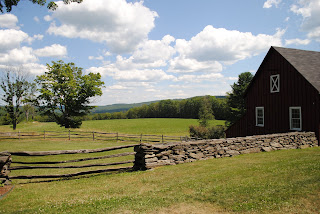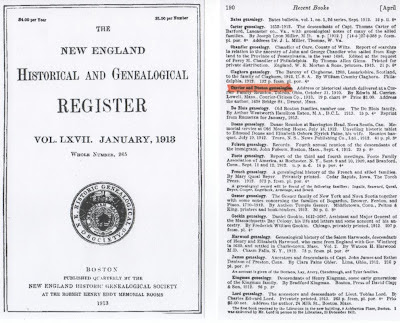My documentation base as described in Parts 1 and 2 is, I believe, pretty strong, including my grandmother's memoirs, a 1925 newspaper clipping, and the 1930 and 1940 Federal Census reports providing me a good start on building a profile of Lenora. But further searches on Ancestry.com revealed very little more to build on. So I moved on to outside sources to see what info could be developed. Using both Lenora's and her husband Ezra's names I plugged into different websites in search of clues. GenealogyBank.com was employed first to see if there were newspaper articles about either of them that might be helpful. I struck out. Next I went into New England Historic Genealogical Society website and searched both names again. I found zip. Both are subscription websites just like Ancestry.com and have frequently been very helpful in other searches in the past. But on this search there was to be no return on my subscription investments. Last I went to Findagrave.com which is a free website with burial info provided by volunteers and found nothing on Lenora. But this time I came up with a hit on Ezra. He is buried in Oxford County, Maine in Bisbeetown Cemetery. I also searched Findagrave to see if any Webbers were buried there but found none. If Lenora is buried near Ezra she certainly is not in the same plot and if she's in the same cemetery she might be there under a different surname.
 |
| Findagrave entry for Ezra H LeBroke |
Every other document I've seen on Ezra spelled Lebroke with no capitalization on the "B" but on his headstone his surname is engraved with the upper case as "LeBROKE." Not sure what difference it makes but will keep that in mind on future computer searches. The stone is also engraved as follows:
"His wife, Abbie Cummings, 1851 - 1882" which supports my suspicions from the 1930 census category of "age at first marriage" that both Ezra and Lenora might have been married previously to other spouses. There was no Webber listed on the Findagrave list of interments in Bisbeetown Cemetery so it appears Lenora is buried elsewhere. So at this point I've sort of run into a dead end on Lenora. But dead ends in genealogy research can sometimes be opened up for access by side stepping to connecting avenues. In this case, I hope to find more information on Lenora by exploring deeper into the profile of Ezra H Lebroke who I now believe is buried in Bisbeetown Cemetery in Oxford County Maine with a previous wife named Abbie Cummings.
Back on Ancestry.com I try to find out more information on Mr. Lebroke who, according to his gravestone, was born in 1854 and died in 1950. There are sources of information to be sifted through, some acceptable as probable and others doubtful. One source that attracts my attention right away is Ancestry.com's hints linking to other member family trees. There were some linked to Lenora too but they were exact duplicates of my profile on her. That leads me to suspect that the other family trees listing Lenora probably just copied off mine, a procedure available on the website as long as the tree your pulling info from is set up as public as opposed to private. Public trees share their info with anyone who wants it. The family trees linked to Ezra were fairly extensive listing his date and place of birth, parental and sibling names, and of most interest to me, spouse information and marriage dates. One precaution important to me is to take info from other family trees with a grain of salt. The website lets you see the profile of the tree owner and their sources of documentation for the profiles they construct in their tree. The owners' frequency of logging on, the longevity of membership, and their self described proficiency, beginner, intermediate, or expert, all together can give you a good idea of how reliable the information may be. It can be a big guessing game sometimes, especially when another tree owner is working from family history files instead of official source documents like census records and certificates. Nevertheless, there are times when you just have to make an educated guess on the info you find and do the best you can to back up "borrowed" info with certifiable documentation.
A family tree on Ezra "Hicks" LeBroke (only had the middle initial "H" up until now) indicated he had three wives, the first of which was Abbie M Hamlin Cummings which should be the same Abbie listed as Ezra's wife on his gravestone. The tree listed a marriage date of 1881 but sadly, per the gravestone Abbie passed away in 1882. The same tree lists a second marriage to Marilla Jane Paige in 1884, and a third to a Nora E Abbott on April 7, 1923. Only the third marriage is backed up by a source, Maine Marriage Records, 1892 - 1996. The computer matched the 1923 marriage to Egra H Lebroke, replacing the "z" with a "g" apparently a transcription error. When I pulled up the name Egra Lebroke on Lenora's profile page the Maine records again listed the 7 April marriage date but listed the bride as Nora E Webber. So it looks to me like I'm closing in on some good info here. Unfortunately, the Ancestry.com website offered transcripted info on this marriage but if I wanted a copy of the marriage certificate itself I would have to pay a fee to a third party to get me a copy from state of Maine Records Dept. Even though I knew better, I went ahead and applied for the copy of the marriage certificate. I knew they would require documentation of my relationship to Lenora but I was hoping the fact that both were born nearly 150 years ago and the marriage was 85 + years ago would exempt me from showing proof of relationship. I was wrong. There's another investment down the drain but I figure sometimes you just got to give it your best shot. Some win, some lose, and some get rained out. So below is what I've got on the 1923 marriage:
From this I will try to pursue a record of Lenora as named above, Nora E Abbott. I hope to build a profile with documentation of her with the married name of Abbott and see where that investigation takes me. So my search for more info on Lenora goes on.

















































